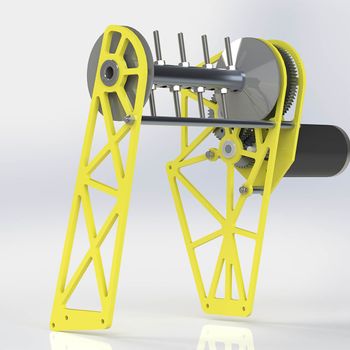DEWBOT XIII Rope Climber
Key climber requirements are:
- Reliability - The climb needs to work every time
- Speed - The climb needs to take <10 sec including engagement. Robots having faster climbs are able to continue scoring longer or delay slow-climbing robots from reaching their ropes
- Shouldn't back-drive
- Don't fall!
Contents
Climber
A number of approaches were prototyped, before designing and developing DEWBOT's climber. The original iteration of the climber comprised an 8" long, 1" diameter aluminum tube having nine 1/4"-20 bolts set at 180 deg and staggered. The bolts engaged loops in our rope, and once engaged, the robot climbed. Printed flanges at the tube ends constrained the coiling rope and kept it from fouling the bearings.
Engaging the loops with the bolts proved too unreliable and slow in practice. After Seneca, the bolt/loop system was replaced by Velcro. In making this change, we clad the aluminum tube with 1" PVC pipe (1.315 in OD) around which adhesive-backed hook Velcro is wrapped.
The climber was designed to mount on the robot superimposed over the shooter, making it space-efficient.
Powerplant & Gearing
The climber is powered by a single CIM motor reduced through a custom 3-stage gearbox. The original gearbox had a 47.8:1 reduction, accomplished by:
- A 12 tooth pinion (Vexpro 217-3099) driving a 34 tooth gear (Vexpro 217-3211), the 34T gear being coaxial with
- A 14 tooth gear (Vexpro 217-3100) driving a 54 tooth gear (Vexpro 217-3220), the 54T gear being coaxial with
- A 16 tooth gear (Vexpro 217-5450) driving a 70 tooth gear (Vexpro 217-3224), the 70T gear being coaxial with and directly driving the climber spool.
The above gearing was consistently reliable,
